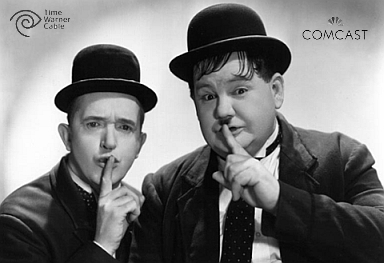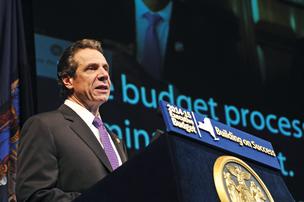 It’s a Merry Christmas from Time Warner Cable, with rate increases for one and all!
It’s a Merry Christmas from Time Warner Cable, with rate increases for one and all!
The cable company that usually waits for the holiday season to end before sending out annual “rate adjustment” notices got an early start this year with some dramatic price changes for many customers, with further rate hikes likely to follow later in 2015.
Taking a lead from Comcast, Time Warner Cable is hiking its broadband modem lease fee from $6 a month to $8 a month in January. That equals $96 a year for a modem that not too long ago used to be included at no extra charge as part of your broadband subscription. A typical customer with a Motorola SB6141 DOCSIS 3 cable modem can buy a brand new unit for nearly $20 less than what Time Warner will collect from customers each year for refurbished or used equipment… forever.
In 2013, Time Warner Cable’s Rob Marcus admitted the company does not charge modem rental fees to defray the cost of the equipment, but as a hidden rate increase designed to generate more revenue.
“The modem fee is a rate increase by all accounts, it takes a different form than usual […] it’s very much a part of the overall revenue generation program,” Marcus told an audience of investment banks.
Customers that lost analog channels after Time Warner Cable began converting part of its lineup to digital-only service were offered free Digital Adapters to continue receiving digital cable channels on older analog sets. Customers were expecting a promised $0.99 monthly lease fee for the devices starting January 1, 2015. Instead customers will now pay $2.75 a month for each DTA device, estimated to cost cable companies less than $50 each three years ago.
But the charges don’t end there.
 The Broadcast TV Surcharge for cable television subscribers will increase from $2.25 to $2.75 a month;
The Broadcast TV Surcharge for cable television subscribers will increase from $2.25 to $2.75 a month;- A new “Sports Programming Surcharge” of $2.75 a month now applies to all cable television customers, whether they watch sports channels or not;
- That on-screen program guide does not come for free. The primary outlet “discounted guide” surcharge is rising from $2.77 to $3.27 a month;
- HBO will increase from $14.99 to $16.99 a month; the Movie Pass package of Encore movie channels and certain other networks is rising $2 a month, from $5.99 to $7.99.
Part of the sales pitch Time Warner makes to justify rate increases is that broadband speeds have increased up to 100Mbps. Except they haven’t in many Time Warner Cable markets, which remain locked in with maximum speeds of 50/5Mbps for the indefinite future.
Thanks to Stop the Cap! reader Joseph for sharing Time Warner’s letter with us.


 Subscribe
Subscribe Time Warner Cable has appealed to the Secretary of the New York Department of Public Service to keep information about taxpayer-subsidized broadband expansion projects in New York a secret.
Time Warner Cable has appealed to the Secretary of the New York Department of Public Service to keep information about taxpayer-subsidized broadband expansion projects in New York a secret. Prestemon rejected efforts by Time Warner Cable to maintain confidentiality even after news of one broadband expansion project was reported by Albany-area media outlets. Prestemon added that public regulatory filings submitted by the company as a project commences effectively places information about it in the public domain.
Prestemon rejected efforts by Time Warner Cable to maintain confidentiality even after news of one broadband expansion project was reported by Albany-area media outlets. Prestemon added that public regulatory filings submitted by the company as a project commences effectively places information about it in the public domain. New York Gov. Andrew Cuomo has set a goal that every resident of New York State should have access to at least 100Mbps broadband no later than 2018.
New York Gov. Andrew Cuomo has set a goal that every resident of New York State should have access to at least 100Mbps broadband no later than 2018.
 That must come as a relief for Verizon. The state’s largest phone company has petitioned state officials in the past for a gradual mothballing of New York’s rural landline network in favor of switching customers to wireless voice and broadband over Verizon’s cellular network. Theoretically, taxpayers could end up subsidizing the demise of rural New York landlines and DSL if Verizon seeks money from the rural broadband fund to expand its wireless tower network in rural New York. Time Warner Cable almost certainly will also seek more funding, probably in excess of the average $1,264 paid to the cable company for each of the 4,114 additional connections it agreed to complete during an earlier round of funding.
That must come as a relief for Verizon. The state’s largest phone company has petitioned state officials in the past for a gradual mothballing of New York’s rural landline network in favor of switching customers to wireless voice and broadband over Verizon’s cellular network. Theoretically, taxpayers could end up subsidizing the demise of rural New York landlines and DSL if Verizon seeks money from the rural broadband fund to expand its wireless tower network in rural New York. Time Warner Cable almost certainly will also seek more funding, probably in excess of the average $1,264 paid to the cable company for each of the 4,114 additional connections it agreed to complete during an earlier round of funding. Austin residents will receive Google Fiber service under three rate plans: $70 for 1,000/1,000Mbps or 5/1Mbps at no charge after paying a $300 construction fee. A package including television costs $130 a month.
Austin residents will receive Google Fiber service under three rate plans: $70 for 1,000/1,000Mbps or 5/1Mbps at no charge after paying a $300 construction fee. A package including television costs $130 a month.
